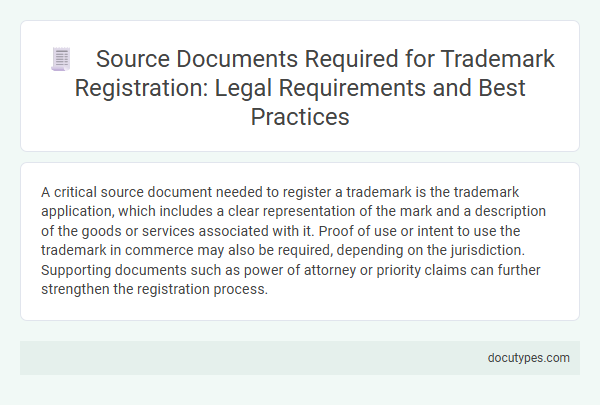A critical source document needed to register a trademark is the trademark application, which includes a clear representation of the mark and a description of the goods or services associated with it. Proof of use or intent to use the trademark in commerce may also be required, depending on the jurisdiction. Supporting documents such as power of attorney or priority claims can further strengthen the registration process.
Introduction to Trademark Registration Source Documents
Registering a trademark requires specific source documents that establish the identity and ownership of the mark. These documents serve as legal proof to protect the trademark and ensure exclusive rights for the registrant.
The primary source document needed is a completed trademark application form that details the mark, the goods or services it covers, and the applicant's information. A clear representation or image of the trademark must also be submitted to define the exact mark being registered. Supporting documents such as proof of use, priority claims from earlier filings, or power of attorney may be necessary depending on jurisdiction requirements.
Legal Importance of Source Documents in Trademark Registration
Source documents are essential to establish the ownership and originality of a trademark during registration. They provide legal proof that supports your claim to exclusive rights over the trademark.
- Proof of Use - Demonstrates that the trademark is actively used in commerce, which is critical for registration and enforcement.
- Assignment or Licensing Agreements - Validates legal transfer or permission regarding trademark rights, ensuring accurate ownership records.
- Specimen or Sample - Shows the actual trademark as it appears in business, aiding in verification by trademark offices.
Core Eligibility Criteria for Trademark Registration
To register a trademark, the primary source document required is an application form submitted to the relevant intellectual property office, such as the USPTO in the United States. This form must include a clear representation of the trademark, the goods or services associated with it, and the applicant's details.
Core eligibility criteria focus on the trademark's distinctiveness and its ability to identify and distinguish your goods or services from others. The mark must not be generic, descriptive without acquired distinctiveness, or likely to cause confusion with existing registered trademarks.
Mandatory Legal Documents for Trademark Application
Registering a trademark requires submitting specific mandatory legal documents to the trademark office. The primary source document is a trademark application form, which includes details such as the applicant's name, address, and a clear representation of the trademark. You must also provide a proof of trademark use or intent to use, along with the payment receipt for applicable filing fees to complete the registration process.
Supporting Evidence: Proof of Prior Use and Ownership
Registering a trademark requires submitting a source document that establishes ownership and proof of prior use. Supporting evidence plays a crucial role in demonstrating the trademark's validity and distinctiveness.
Examples of supporting evidence include sales receipts, advertising materials, and packaging that display the trademark in use. You must provide clear documentation proving the continuous use of the mark to strengthen your registration application.
Applicant Identification and Authorization Requirements
What source document is needed to register a trademark focusing on applicant identification and authorization requirements?
The primary source document required is a valid proof of identity for the applicant, such as a government-issued ID for individuals or official registration certificates for businesses. Authorization documents, like a power of attorney, may be necessary if a legal representative files the application on behalf of the applicant.
Special Documents for Foreign Applicants
Registering a trademark requires specific source documents, especially for foreign applicants. These documents prove eligibility and ownership for trademark protection in a new jurisdiction.
- Priority Document - Evidence of earlier trademark filing in the home country to claim priority rights under international agreements.
- Power of Attorney - Authorization for a local representative or attorney to act on Your behalf during the registration process.
- Certified Translation - Official translations of foreign documents to comply with local language requirements in the trademark office.
Submitting the correct special documents ensures efficient processing of Your foreign trademark application.
Common Errors in Trademark Document Submission
Registering a trademark requires submitting the correct source document to the relevant trademark office. Common errors in trademark document submission can delay or jeopardize your application process.
- Incorrect or Incomplete Specimen - Submitting a specimen that does not clearly show the trademark in use can lead to rejection.
- Misclassification of Goods or Services - Choosing the wrong trademark class may cause processing delays or invalidate the registration.
- Missing Required Signatures - Failing to include authorized signatures on the application results in non-compliance and possible refusal.
Best Practices for Document Preparation and Filing
| Source Document for Trademark Registration | Best Practices for Document Preparation and Filing |
|---|---|
|
|
What Source Document Is Needed to Register a Trademark? Infographic

